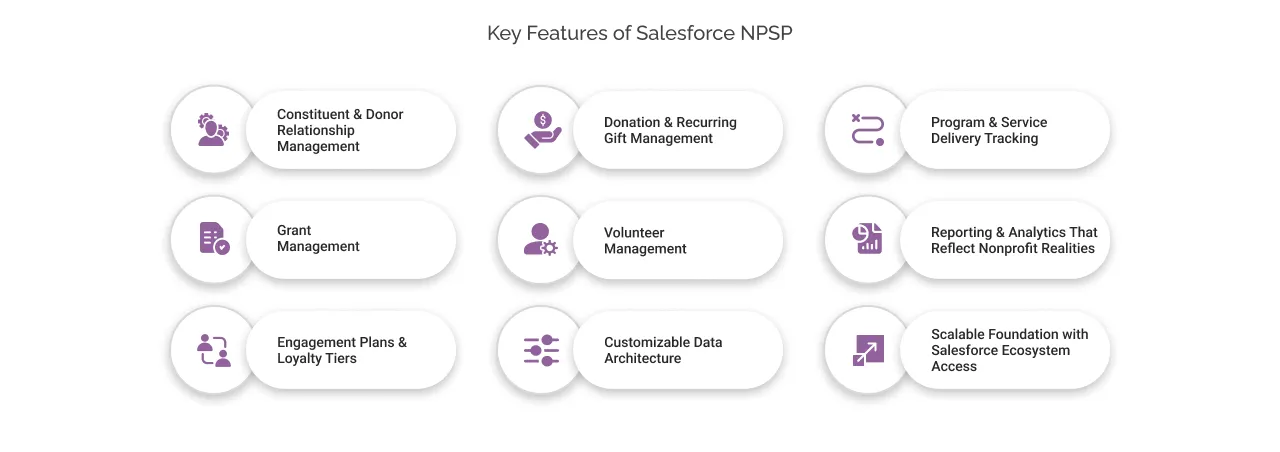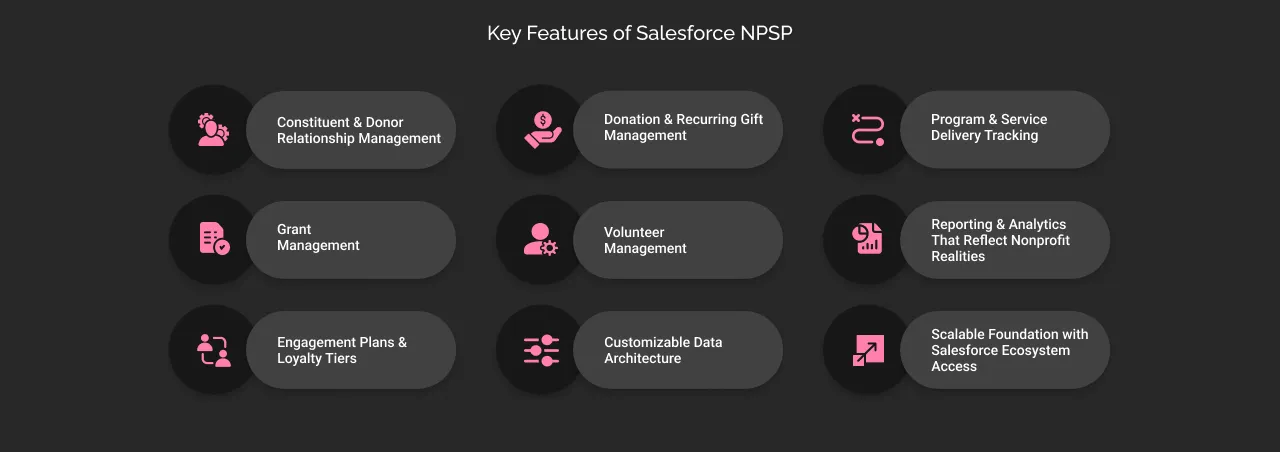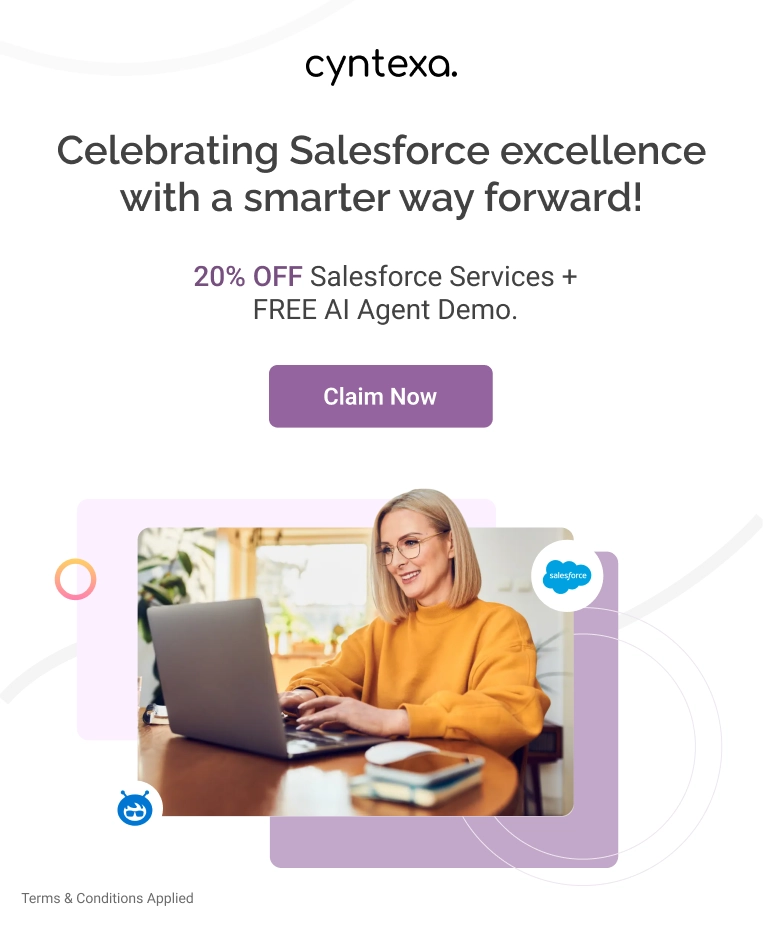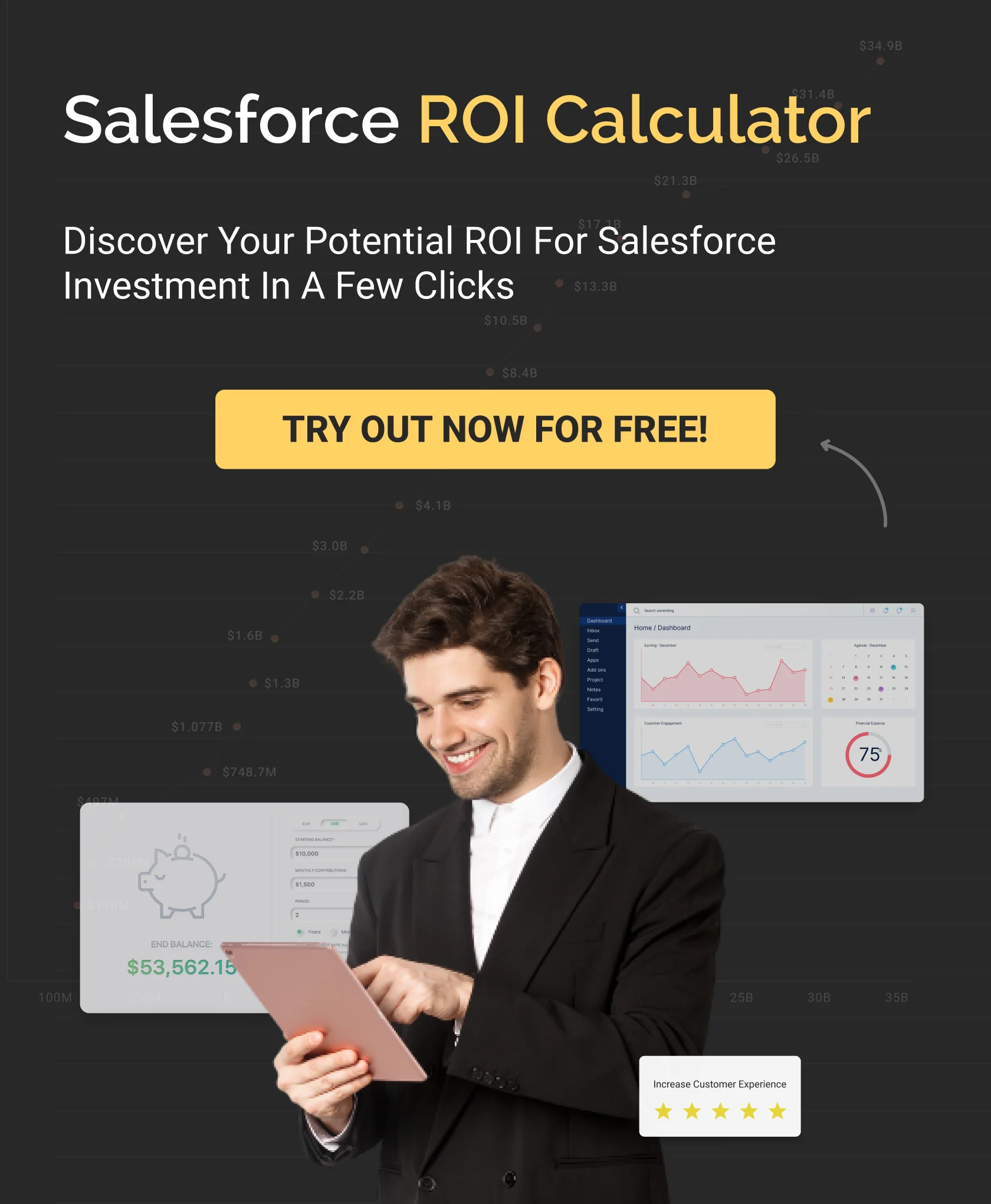How Nonprofits Can Benefit From Implementing Salesforce NPSP?
Table of Contents
Most nonprofits realize that technology can make a whole difference in the way they operate. As per the Salesforce Nonprofit trends report, 82% of the users say it helps increase their impact, but the reality is, 48% still stuck with the manual management of operations. This means that donor data is not unified, processes are slow and dependant, and teams are left doing too much with too little.
Salesforce Nonprofit Success Pack is designed to address the above and endless root cause challenges nonprofits face.
Salesforce NPSP is a free, open-source extension of Salesforce made specifically for nonprofits. It turns the Salesforce platform into a CRM that is customized to assist nonprofits with their mission success, to manage donations, track programs and whatnot.
This blog covers what Salesforce Nonprofit Success Pack is, what features it offers and how nonprofit organizations can benefit from it.
What Challenges are Nonprofits Facing Today?


Digital transformation in the nonprofit sector is about rethinking operations, re-aligning teams, and defining accurately how impact is scaled. Despite good intentions and growing tech awareness, many nonprofits are still afraid of depending on technology.
Here are the most pressing challenges nonprofits face today and the real-world implications behind them.
1. Manual Data Entry Drains Time and Energy
Almost half of the nonprofits rely on manual data entry, often managing data in spreadsheets, emails, and disconnected tools across departments. On the surface, this reduces the efficiency of day-to-day workflows, but beneath that, it congests donor history data, misses follow-ups that can be converted, and limited visibility into what’s working.
Most of the time, organizations manually update Excel sheets with donation info, then enter the same data into email platforms or grant reports. Not only is this error-prone, but it also limits real-time decision-making and the fundraising process. A CRM-centric solution designed for nonprofits can reduce admin overhead, not add to it.
2. Siloed systems create inconsistent experiences
Data is not hard to manage; it’s often scattered across multiple systems. Donor information, volunteer data, and program outcomes are often stored in separate tools. This creates gaps in communication, data synchronization, delays in reporting and a lack of unified storytelling across campaigns.
This disconnect can negatively impact the outreach. A long-term follower/supporter might get a “first-time donor” email or missed recognition for their support. Integration between fundraising, marketing, and program data is important, but few systems offer this natively without costly custom development.
3. IT skills gaps create obstacles to progress
As per Salesforce, 37% of nonprofit professionals are worried about the loss of human expertise or job displacement due to automation. They often hesitate when adopting tools that feel too technical or disconnected from what they are used to operating on. Many small to mid-size nonprofits operate without a dedicated system administrator and rely on generalist staff who juggle CRM tasks with core program management responsibilities.
When platforms require ongoing configuration or technical maintenance, adoption gets delayed, and valuable features go unused. What these organizations need are tools that empower them, not overwhelm them, solutions that balance functionality with usability and help staff where they need.
4. Low Risk Tolerance Delays Innovation
While many nonprofit leaders understand the importance of technology, there is still a visible gap in risk tolerance. Sometimes it’s a poor experience with costly tools or overwhelming outcomes that makes them cautious about committing to large-scale changes. Without clear proof of value or alignment with strategic goals, technology investment decisions get deprioritized.
This hesitancy is especially common in organizations where digital transformation isn’t treated as a mission-enabling upgrade. When innovation lacks executive sponsorship, potential impact remains untapped.
5. Budget Structures Restrict Long-Term Planning
Funding also plays an important role in introducing technology in nonprofit organizations. Many of them are already operating on short-term or limited grants, making it difficult to invest in technology. Even core infrastructure is rarely given attention in funding proposals, leading organizations to work with short-lived tools that address immediate needs but don’t support long-term growth.
Even when a CRM or automation is available for free or at a discounted rate, associated costs like customization, data migration, and training. These costs fall outside the budgets that are merely getting approved, restricting organizations from using digitally-smart systems for improved efficiency.
If your nonprofit is also facing similar issues, then know these are not the signs of failure. They are indicators that your organization needs a system that aligns with your operations and practices.
Salesforce NPSP is the comprehensive solution you need. Why? Let’s explore.
What Is Salesforce Nonprofit Success Pack (Salesforce NPSP)?
The Salesforce Nonprofit Success Pack (NPSP) is a free, open-source configuration of Salesforce CRM tailored to address the needs of mission-driven organizations. Built on top of Salesforce Sales Cloud, it offers enterprise-grade CRM features in tools that reflect how nonprofits actually work.
Its capabilities are designed to cater to fundraising, donor stewardship, volunteer coordination, program tracking and impact reporting.
Instead of making nonprofits adapt for-profit models, NPSP reconfigures Salesforce’s standard architecture, like accounts, contacts, opportunities, and campaigns, into a structure optimized for nonprofit work. This includes Donations, Households, Engagement Plans and Recurring Gifts. This helps nonprofits to manage their donor relationships and outcomes from a mission-first approach.
It was originally developed through a partnership between Salesforce.org and the global nonprofit community. NPSP has now grown into a widely adopted solution trusted by thousands of organizations worldwide.
It’s not a standalone product but part of the broader Salesforce ecosystem. Salesforce NPSP is compatible with AppExchange apps, prebuilt modules like Program Management or Outbound Funds, and scalable into Salesforce Nonprofit Cloud as organizational needs evolve.
Designed to be flexible and scalable, NPSP empowers both grassroots teams and large global NGOs to start quickly, operate efficiently, and grow their impact, without needing a large in-house technical team.
Compatibility with Salesforce Nonprofit Cloud
While Salesforce Nonprofit Cloud is considered the new-generation AI-powered CRM for nonprofits, NPSP remains fully supported and widely adopted. It serves as an ideal foundation platform for organizations looking to tap the potential of digital maturing, while offering a smooth path to scale when advanced capabilities are needed, or when operations scale.
Key Features of Salesforce NPSP


Below are the nine key features of Salesforce NPSP that show how nonprofits can manage their work while experiencing a reduction in manual labor and ready-to-present impact:
1. Constituent & Donor Relationship Management
Managing relationships requires more than tracking donations. NPSP provides you with a connected, 360-degree view of every individual, household and organization involved with your nonprofit.
1. Household and Organizational Mapping
- NPSP allows staff to organize constituents into households and affiliations, collecting data related to giving history, communication preferences and volunteer records in one place.
- This makes it easier to see how a major gift from a company might be influenced by its employees’ volunteerism or board engagement.
2. Multi-Dimensional Relationships
- You can also create records of informal relationships, like a mentor and mentee, as well as the formal ones, like chapters and parent organizations.
- This improves targeting, personalization, and stewardship across programs, donors, and advocates.
2. Donation & Recurring Gift Management
Fundraising is one of the core activities in nonprofits, and NPSP offers native tools to manage every type of giving, from major gifts to recurring online donations.
1. Streamlined Gift Entry and Acknowledgment
- Teams can log one-time, recurring, and pledged gifts across channels, including checks, online portals, events and automate thank-you message workflows.
- Custom rules provide out-of-the-box support for soft vs. hard credits, matching gifts, and tribute gifts, helping nonprofits maintain accurate attribution.
- It also includes setting up and managing recurring donation that can schedules, tracking payment information, and forecasting revenue. This feature also helps organizations plan and budget more effectively by providing insights.
2. Giving Lifecycle Visibility
- Fundraisers can view a donor’s entire journey from first contact to recurring supporter. It helps them identify drop-off points and design re-engagement strategies.
3. Program & Service Delivery Tracking
For nonprofits that focus on delivering community programs or services, tracking who’s receiving what and when is important. NPSP assists this through its optional Program Management Module (PMM).
1. Client Enrollment and Service History
- Nonprofits can now enroll individuals into programs, log service delivery (like meals, classes, or counselling sessions), and track attendance and outcomes in NPSP.
- Intake forms, referrals, and follow-ups are stored within the same ecosystem, which frees the staff from managing records manually.
2. Demographic and Equity Analytics
- Organizations can analyze which populations are being served and where gaps exist, supporting equity-driven program expansion.
- These insights play a huge role in grant reporting and impact evaluations.
4. Grant Management
Many nonprofits find it difficult to manage multiple restricted and unrestricted grants with different compliance requirements and reporting deadlines. NPSP simplifies this process by connecting funding sources to programs and outcomes.
1. Inbound & Outbound Fund Tracking
- You can link grants to a particular program, expense or service output.
- This way, nonprofits can easily allocate budgets transparently to avoid compliance risks.
2. Milestone & Compliance Management
- Users can track grant deadlines, deliverables, and funder-specific metrics. It helps in submitting reports in alignment with agreed-upon outcomes and on time.
- This prevents lost funding due to administrative oversight.
5. Volunteer Management
Volunteers are considered the backbone of nonprofit operations. Through Volunteers for Salesforce (V4S), NPSP enables seamless volunteer scheduling, tracking and engagement.
1. Detailed Volunteer Profiles
- Teams can record skills, interests, availability and certificates of each volunteer under their respective record.
- This allows managers to give personalized assignments to each volunteer and avoid underutilization of committed individuals.
2. Scheduling, Shift Management, and Hours Tracking
- Volunteers can sign up for shifts, log hours, and receive automatic reminders, all managed under one system.
- Reports on total hours and role-specific contributions help quantify impact for internal and external stakeholders.
6. Reporting & Analytics That Reflect Nonprofit Realities
Nonprofits need to narrate compelling stories to boards, funders and communities that are inclusive of data. NPSP includes 70+ pre-built reports designed specifically for mapping the performance of nonprofits’ efforts.
1. 70+ Impact-Centric Reports
- Reporting and Analytics show donor retention and churn, year-over-year growth, soft vs. hard credit summaries, and constituent lifetime value.
- You can also view grant tracking and disbursement cycles for operational and funder-facing use.
2. Board & Funder-Ready Dashboards
- Reports are tailored to the language nonprofits use. You don’t need to repurpose all that data into B2B sales templates.
- This ensures teams can walk into meetings with clean, compelling visuals that back strategy and funding asks.
7. Engagement Plans & Loyalty Tiers
Nonprofits often design their programs for long-term support, and to make sure it happens, an intentional and structured engagement system is required.
Engagement Plans in NPSP help nonprofits create repeatable workflows that build relationships over time.
1. Task-Based Workflows
- Teams can design automated task series for different supporter journeys, such as welcoming a new donor or re-engaging a lapsed volunteer.
- These workflows reduce manual tracking and ensure consistent follow-up.
2. Recognition Levels & Badges
- Organizations can assign levels or milestones to donors and volunteers, supporting segmentation, appreciation, and targeted campaigns.
8. Customizable Data Architecture
Every nonprofit is working differently, and NPSP supports that. Its metadata-driven architecture supports deep customization without needing to rebuild a new system from scratch.
1. Add Fields, Objects, and Custom Workflows
- Admins can create new objects and fields aligned to activities like tracking animal rescue, organizing scholarship applications or legal services into the NPSP ecosystem.
- Built-in automation supports notifications, escalations, or document generation.
2. User-Friendly Configuration, Not Coding
- Most of the customization is done through point-and-click tools in Salesforce setup, which makes it easy to train nonprofit admins and consultants.
- This saves consulting hours and promotes self-sufficiency.
9. Scalable Foundation with Salesforce Ecosystem Access
NPSP is built natively on Salesforce, which gives nonprofits a growth-backed foundation, which is supported by 10 free licenses through the Power of Us program.
1. Extend via AppExchange
- You can integrate tools for online donation forms, marketing platforms, finance systems, and impact analytics directly into the CRM, without losing data continuity.
2. Upgrade Anytime to Salesforce Nonprofit Cloud
- You can anytime move from Salesforce NPSP to Nonprofit Cloud while keeping your data and processes as it is. This ensures long-term tech scalability aligned with the growth of the organization.
Benefits of Implementing Salesforce NPSP
For most nonprofits, the real challenge is coordination among different processes, operations and workflows. Salesforce NPSP addresses these issues by offering a practical, sustainable way to align people, processes and outcomes.
Here are the benefits of implementing Salesforce NPSP and how it delivers impact where it matters most:
1. More Donor Revenue, Less Operational Block
Too often, nonprofit staff juggle donors in spreadsheets or disconnected tools, leading to missed follow-ups and generic communications. Nonprofit Success Pack brings all donor data, including giving history, past interactions, and event attendance, into one place. This enables smaller teams to nurture relationships with consistency, resulting in stronger engagement and better donor retention without having to onboard staff.
This is one of the fastest paths to improved donor lifetime value without increasing operational cost.
2. Clearer Visibility for Smarter Board & Grant Reporting
Nonprofits have different functions like fundraising, program delivery, grant reporting, etc., and each team needs access to different kinds of data. With Salesforce NPSP, reports and dashboards aren’t managed manually; they’re embedded in the workflows.
This means development teams can track revenue goals in real-time, while executive-level associates can present visually appealing and impact-focused reports to the boards, without having to make last-minute updates to the data.
This level of clarity helps nonprofits not only stay audit-ready but also build trust with funders who expect transparency.
3. Reduces Administrative Overhead Without Sacrificing Quality
Administration tasks cover a lot of a nonprofit’s operations, causing burnout when teams are handling everything manually. NPSP automates day-to-day tasks like sending acknowledgement emails, monthly giving reminders and follow-up work, allowing teams to focus on more impact-driven duties.
This helps small teams improve productivity and avoid burnout simultaneously maintaining a personalized experience for constituents.
4. Help You Get Large-Scale Grants and Long-Term Partnerships
Funders prioritize nonprofits that can show outcomes in real-time, not just the intent. With structured data around donor impact, program reach, and service delivery, NPSP enables you to tell a story with numbers, not just plain narratives. Be it submitting a grant report or pitching a new partnership, having verifiable data readily available gives you a strong ground.
5. Improves Team Alignment by Eliminating Data Silos
In many nonprofit organizations, fundraising, program, and leadership all measure performance differently. This lack of alignment in performance tracking practices causes miscommunication and missed opportunities. NPSP cuts down these barriers by giving all teams access to the real-time data.
Whenever a donor supports a specific initiative, the program’s team gets notified. When a volunteer becomes a donor, the development team sees the full journey.
This kind of alignment drives not just efficiency, but organization-wide productivity, where everyone’s moving together.
6. Reduced Risk from Data Loss or Staff Turnover
Turnover is inevitable in any nonprofit, but losing institutional data shouldn’t be. NPSP centralizes all crucial information, including donor preferences, program notes, and impact insights, keeping every piece of data intact and safe, even in the situation where someone leaves the organization. The next team member can pick up right where the last one left off, without needing to rebuild relationships from scratch.
From a business perspective, this reduces ramp-up time, minimizes donor attrition, and ensures continuity in operations.
7. Prepares You for Growth Without Forcing an Overhaul
Most off-the-shelf CRMs break down as your program scales or your team structure changes. NPSP is natively built on Salesforce, and it never falls apart when your scaling needs show up. Whether you’re adding chapters, launching new programs, or expanding your impact globally, you won’t need to replace your entire system and databases. You adapt this nonprofit-powered CRM, not the other way around.
Consultants often see organizations begin with basic fundraising and later evolve to complex grantmaking or service delivery, without needing to migrate platforms.
Salesforce NPSP in Action: Real-World Example Of Successful NPSP Implementation
When your mission depends on timely donations and meaningful communication, even small inefficiencies can disturb the donor experience.
This was the case for one of the clients we served. A medical relief organization that was operating globally across 70+ countries faced challenges like fragmented workflows, delayed notifications, incomplete donor acknowledgement, and time-consuming manual lead capture.
The transformation began when they reached out to us for Salesforce Development Services and got their Salesforce NPSP customized and integrated. The results spoke for themselves:
- 25% reduction in manual effort
- 30% improvement in lead capture accuracy
- 30% increase in donor turnaround time
This success story shows how the right NPSP enhancements can align donor operations, increase transparency, and help nonprofits create more meaningful engagements, without overwhelming their entire system.
Access the Full Success Story to Learn What Worked, and Why.
Salesforce NPSP Pricing & Licensing
Here is a detailed breakdown of Salesforce NPSP pricing, what it actually saves you and where hidden costs may occur.
1. Free Salesforce Enterprise Licenses Through the Power of Us
Through its Power of Us program, Salesforce offers 10 Free Enterprise edition licenses to eligible nonprofits. These licenses come with full access to NPSP and Salesforce’s core CRM features.
A single Salesforce Enterprise license typically costs $150/user/month, meaning the grant covers a value of $18000 yearly.
What this means for nonprofits:
- You gain access to enterprise-grade CRM tools at zero licensing cost for your core team.
- It is ideal for small-to-mid-sized nonprofits that want to scale but don’t want to risk funds in big software investments.
- This also allows leadership to test and prove early ROI before committing further funds.
2. Discounted Add-On Licenses for Growth
If you need more than 10 licenses, Salesforce offers additional licenses at discounted nonprofit rates, i.e. $36/user/month for Enterprise Edition, and $60 to $100/user/month for Nonprofit Cloud Editions.
What this means:
- You retain full system continuity as you grow, without having to re-platform or migrate data.
- Budget predictability improves as licensing costs grow in proportion to team size and program scale.
- Nonprofits can start slow, then scale intentionally.
Total Cost of Ownership: What’s Not Covered in Licenses
While Salesforce just provides the licenses, implementation is a whole other story. Salesforce NPSP development, configuration, training, and system alignment still need technical expertise.
Many nonprofits choose to engage a implementation partner to streamline donor journeys, migrate data from legacy systems to Salesforce NPSP, and build tailored fundraising workflows that reflect their mission. In most cases, this also includes enhancing the platform through extend NPSP with Salesforce development to support nonprofit-specific processes like grantmaking, recurring donations, and volunteer program logic.
The right Salesforce partner understands nonprofit challenges and also brings architectural expertise that gives them a scalable and technically sound setup.

The Final Note
Technology can sometimes overwhelm your teams when they’re in the middle of juggling programs, fulfilling donor commitments, and managing internal operations. But it shouldn’t be. Salesforce NPSP brings clarity and unification to this chaos with no complexity, by helping your organization streamline what you already do best.
When set up the right way, it gives nonprofit leaders a system that works behind the scenes, allowing them to focus on relationship building and outcomes that truly matter.
That’s why implementing NPSP correctly becomes more than a technical process. At Cyntexa, we work as a Salesforce NPSP implementation partner helping teams configure the platform around their real operational needs, not the other way around.
Our experts collaborate with you to get the system working the way you need it to, so the technology becomes a foundation for impact, not another hurdle to overcome.
Don’t Worry, We Got You Covered!
Get The Expert curated eGuide straight to your inbox and get going with the Salesforce Excellence.
AUTHOR
Shubham
Service Cloud, Salesforce Managed Packages
With over 5 years of experience, Shubham specialize in curating solutions on Salesforce Service Cloud, Nonprofit Cloud, Consumer Goods Cloud, Managed Packages, and ServiceNow ITSM. He designs and implements end-to-end service solutions that improve operational workflows and ensure seamless integration across enterprise systems. Shubham’s expertise lies in creating secure, efficient, and agile platforms tailored to unique business needs.


Cyntexa.
Join Our Newsletter. Get Your Daily Dose Of Search Know-How
Frequently Asked Questions
The Salesforce Nonprofit Success Pack or NPSP is a free platform and it remains free for the first 10 licenses. Non-profit, not-for-profit, public charity, foundation, K12, or higher educational heads are eligible for the first 10 licenses at no cost.
With the help of Salesforce NPSP, NGO institutions can:
- Organise donor database based on demographics, history, preferences, etc.
- Segment donors based on amount, frequency, and engagement grade.
Yes, Salesforce NPSP can help with volunteer management by:
- Enhancing volunteer engagement through effective onboarding, communication, and feedback process.
- Implementing effective volunteer data records by tracking their engagement regularly.
A small nonprofit organisation with limited resources indicates its financial restraints. Salesforce NPSP is highly suitable because of its free and open platform with 10 licenses and zero charges. Also, it helps small nonprofit institutions to manage donors, and streamline various other operations.







